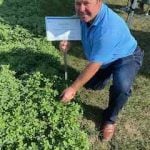Manitoba’s general farm group wants tax relief for producers in a year of drought, grasshopper infestations, the fallout from bovine spongiform encephalopathy and the prospect of low grain prices.
Keystone Agricultural Producers is urging the provincial government to eliminate the special levy for education on farmland and production buildings. According to KAP estimates, Manitoba farm families pay $40 million a year in education taxes through that levy.
The elimination of the tax would help farm families withstand the current crisis, while demonstrating the province’s commitment to their survival, said KAP president Weldon Newton.
Read Also

Agriculture ministers commit to enhancing competitiveness
Canadian ag ministers said they want to ensure farmers, ranchers and processors are competitive through ongoing regulatory reform and business risk management programs that work.
Municipal and school taxes in Manitoba are due at the end of October. KAP officials predict that many producers will not have the money to cover those taxes, which are based on farmland and property assessments rather than farm income or the ability to pay.
“The whole farm income situation is extreme,” said KAP vice-president David Rolfe, who saw his dugout dry up this year for the first time in memory. “It’s creating an awful lot of hardship in rural Manitoba.”
There are areas of the province this year where almost no rain fell during the growing season. The drought, coupled with weeks of intense heat, bit into crop yields and resulted in cattle having to be fed at least two months ahead of normal in the worst affected areas.
Barry and Laurie Flannery are among the producers wading through the rising tide of difficulties this year. They had virtually no rainfall at their cattle farm near Pipestone this summer. They are already spending a lot of money on feed.
“There’s no pasture left out here,” Laurie said. “The grasshoppers and drought took it all.”
Like many cattle producers in the province, they are struggling with the question of how much to invest in hay and straw when they don’t know what the coming months will bring in terms of cattle prices. Prices have been badly depressed since the discovery in May of a lone case of BSE at an Alberta farm.
The cropping year in Manitoba was not the disaster many had feared before harvest began, however. There were regions, particularly in eastern Manitoba, where producers harvested above average crops. And grain industry analysts are predicting that the overall wheat and barley yields in the province should be at least average.
Widespread crop failures in the Interlake did not materialize either. Dave Shott had less than 50 millimetres of rain throughout the growing season at Arborg, but still harvested yields that were decent considering the dry weather.
“It wasn’t a bumper year, but it wasn’t a total writeoff, either,” he said.
However, poor pasture conditions are prevalent throughout much of Manitoba, and rains will do little to revive the worst pastures for fall grazing. Shott said there are pastures farther west from him that were grazed bare this summer.
As for the tax relief being sought by KAP, he said he would welcome it.
“I don’t have any problem paying taxes on the home quarter and for school, but when a guy’s running a couple of thousand acres, it gets to be fairly pricey.”














